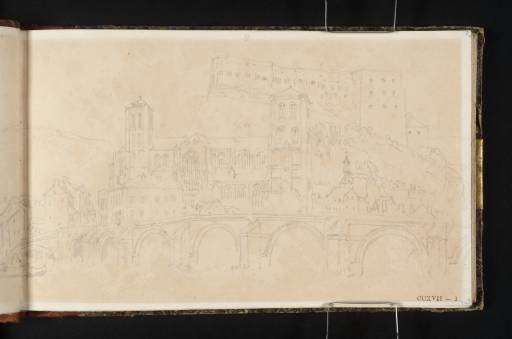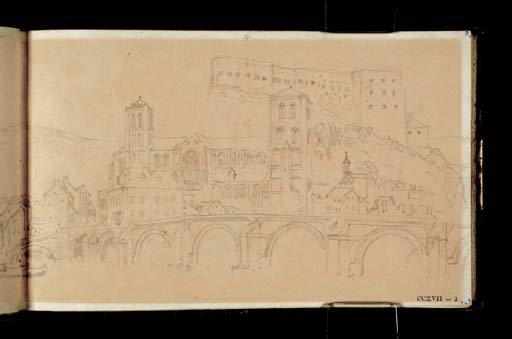Joseph Mallord William Turner The Citadel, Church and Bridge at Huy, Looking Upstream 1824
Image 1 of 2
Joseph Mallord William Turner,
The Citadel, Church and Bridge at Huy, Looking Upstream
1824
Joseph Mallord William Turner 1775–1851
Folio 3 Recto:
The Citadel, Church and Bridge at Huy, Looking Upstream 1824
D20088
Turner Bequest CCXVII 3
Turner Bequest CCXVII 3
Pencil on off-white wove paper, 99 x 162 mm
Watermark ‘[...]lls | 1[...]’
Inscribed in blue ink by Ruskin ‘3’ top right and ‘247’ bottom right
Stamped in black ‘CCXVII–3’ bottom right
Watermark ‘[...]lls | 1[...]’
Inscribed in blue ink by Ruskin ‘3’ top right and ‘247’ bottom right
Stamped in black ‘CCXVII–3’ bottom right
Accepted by the nation as part of the Turner Bequest 1856
Exhibition history
1904
National Gallery, London, various dates to at least 1904 (601f, as ‘Ten Leaves from a Book of Sketches on the Rhine and Meuse’).
1991
Turner’s Rivers of Europe: The Rhine, Meuse and Mosel, Tate Gallery, London, September 1991–January 1992, Musée Communal d’Ixelles, Brussels, February–April 1992 (38, reproduced).
References
1904
E.T. Cook and Alexander Wedderburn eds., Library Edition: The Works of John Ruskin: Volume XIII: Turner: The Harbours of England; Catalogues and Notes, London 1904, pp.302, 636 no.601f, as ‘Ten Leaves from a Book of Sketches on the Rhine and Meuse’.
1909
A.J. Finberg, A Complete Inventory of the Drawings of the Turner Bequest, London 1909, vol.II, p.682, as ‘Huy. Continuation of drawing on p.2a. Reverse of Exhibited Drawing, 601f, N.G.’.
1975
Malcolm Cormack, J.M.W. Turner, R.A. 1775–1851: A Catalogue of Drawings and Watercolours in the Fitzwilliam Museum, Cambridge, Cambridge 1975, pp.56 no.29, 64 no.41 note 1 [p.68].
1991
Cecilia Powell, Turner’s Rivers of Europe: The Rhine, Meuse and Mosel, exhibition catalogue, Tate Gallery, London 1991, p.41 note 15, [p.60], 123 no.38 reproduced.
This highly wrought drawing shows a wide-angled view of Huy, extending onto the folio opposite (Tate D20087; Turner Bequest CCXVII 2 a). Drawing from the Quai des Recollets, Turner records the ancient stone bridge which traverses the Meuse and a further single-arched bridge, the Pont St Nicholas, to the far left of it. The majestic Church of Notre-Dame follows, its lofty towers leading the eye to Huy’s citadel, a great bulk of a building remodelled by the Dutch during their occupation of Huy in 1818.1 Given its commanding position, Bartholomew Stritch writes that the fortress was historically a ‘great object of contention’ and ‘was taken and retaken, numberless times during the civil wars that so long devastated the country’.2 Its nineteenth-century reparations and augmentations, however, put the citadel ‘in the most formidable state of defence’: a ‘great portion of the works have been hewn out of the solid rock, and towering walls of massive masonry superadded to the precipices upon which it stands to render it impregnable’.3 In contrast to the stolid rectilinear mass of the citadel is the Church of Notre-Dame below, a fourteenth-century Flamboyant Gothic building constructed on Romanesque foundations. Turner delicately reproduces the tiers of pointed arches and lancet windows, making further studies of the church’s apse and Bethlehem portal in the Rivers Meuse and Moselle sketchbook (Tate D19631; Turner Bequest CCXVI 41).
Technical notes:
The paper has mottled and browned significantly, a result of the drawing’s prolonged exhibition and exposure to sunlight during the nineteenth century.
Alice Rylance-Watson
January 2014
How to cite
Alice Rylance-Watson, ‘The Citadel, Church and Bridge at Huy, Looking Upstream 1824 by Joseph Mallord William Turner’, catalogue entry, January 2014, in David Blayney Brown (ed.), J.M.W. Turner: Sketchbooks, Drawings and Watercolours, Tate Research Publication, April 2015, https://www


